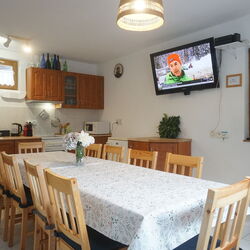Berries in a jar
Between Lake Balaton and the Kis-Balaton, near Sármellék, lies a small orchard where black chokeberries, rosehips, and Cornelian cherries have found a home. At Tüskevár Kert, every fruit is hand-harvested and processed without chemicals or artificial additives. If you’ve never tried rosehip or Cornelian cherry jam, now is the perfect time.
"I love the fresh air and being close to nature."
Though Gergely Tihanyi trained as an IT specialist, it soon became clear that his heart belonged outdoors, working with the land. Family vineyards, childhood gardening memories, and inherited farmland all led him to establish his own orchard over ten years ago.
What began as a hobby chokeberry plantation has now grown into a two-hectare farm, managed together with his father — and turned into a full-time passion.
Reviving forgotten treasures of the Carpathian Basin
Tüskevár Kert focuses on cultivating and processing berries, especially traditional Carpathian Basin varieties that are often overlooked or forgotten.
Gergő intentionally chose resilient, health-promoting plants:
“We don’t just grow these for sale — this is what we eat and share with our family and friends.”
The garden features rosehips, Cornelian cherries, black chokeberries, blackcurrants, blackberries, and blue grapes. Their uniqueness lies not only in the selection of fruits but also in the mindful, hands-on approach to growing and processing. All fruits are picked by hand and processed fresh. They produce 100% pure juices by pressing, and sugar-free or lightly sweetened jams by gentle cooking — always using methods that preserve the fruits' natural qualities.
Even leftover fruit skins are repurposed into dried snacks, powders, or herbal tea blends. The products are free from additives and usually sugar-free as well.
Each fruit is processed according to its unique properties: Rosehips and Cornelian cherries, for instance, are ideal for jams thanks to their dense flesh and need no additional thickening agents. Their naturally tart flavors can be enjoyed in sugar-free or sweetened versions.
Alongside family recipes, Gergő is constantly experimenting with new flavors and techniques, while staying true to the principles of artisanal production.
Product highlights
Rosehip and cornelian cherry jams
Tüskevár Kert’s signature jams — rosehip and Cornelian cherry — stand out not only for their distinctive flavors but also for their exceptional nutritional value. These are not cultivated, sweetened varieties but wild fruits, processed with patience and skill.
Rosehips are harvested at full ripeness, then heat-treated and pressed to remove the seeds, leaving only the rich, silky pulp. The result is a dark orange jam with a balanced sweet-tart flavor, naturally high in vitamin C and antioxidants. No added pectin or gelling agents are needed — the fruit’s own texture does the job.
Cornelian cherry jam is a true rarity. Few producers work with this wild fruit, which takes years to yield harvests. Its flavor is unmistakable: tart, with subtle plum-like notes and a naturally low sugar content.
Produced in small batches from their own harvest, these jams contain no additives or preservatives.
Where to buy
- Hévíz Farmers’ Market
- Liliomkert Market, Káptalantóti
More information & Contact:
The Life-Giving Winds of the Ice Age: How Loess Shaped the Land Did you know that Transdanubia’s rich, golden soils are actually a gift from the winds of the Ice Age? Loess isn’t just a dry geological term — it’s an ancient natural recipe that gave rise to some of the most fertile soils in the Carpathian Basin. Where vineyards grow today and birds nest in loess cliffs, strong winds once carried yellow dust across the landscape — for thousands of years. Learn how this unique sediment shaped the land and why loess is still essential for sustainable farming today. What Is Loess and How Did It Form? The term loess comes from the German word lose, meaning "loose." Loess is a fine-grained, yellowish sediment that was deposited during the Pleistocene epoch (2.58–0.01 million years ago), particularly during glacial periods. It formed in periglacial environments south of the great Scandinavian ice sheet — cold, dry landscapes with little or no vegetation. The dust was carried by strong Ice Age winds from floodplains and barren steppes, and slowly accumulated over tens of thousands of years. Eventually, calcium carbonate cemented these layers into loess, which developed characteristic vertical fissures. It’s important to note that the Pleistocene wasn't a single “Ice Age,” but a period that included alternating cold and warm phases — some even warmer than today. Loess and the Landscape Loess gave the Carpathian Basin — especially Transdanubia — its distinct terrain. Steep loess cliffs (sometimes up to 10 meters high), caves that provide nesting sites for bee-eaters and sand martins, centuries-old sunken roads carved into hillsides, and exposed root systems are all part of the landscape’s geological legacy. Together, they define the unique character of this region — shaped by time, wind, and stone. Fertility and Water Retention Loess-rich areas have produced some of the most fertile soils in the region. Many local producers farm on land that sits atop loess. This creates an excellent foundation for agriculture — not just because of the high humus content, but also because loess has outstanding water-holding capacity. Its vertical pores allow moisture to penetrate deeply and remain in the soil, even during dry periods. A Modern Echo — Dust from the Sahara Interestingly, the fine Saharan dust that now reaches Central Europe more frequently can be seen as a modern counterpart to loess-forming material. It’s a reminder that the powerful natural forces that shaped the land long ago are still at work today — just on a different scale.















